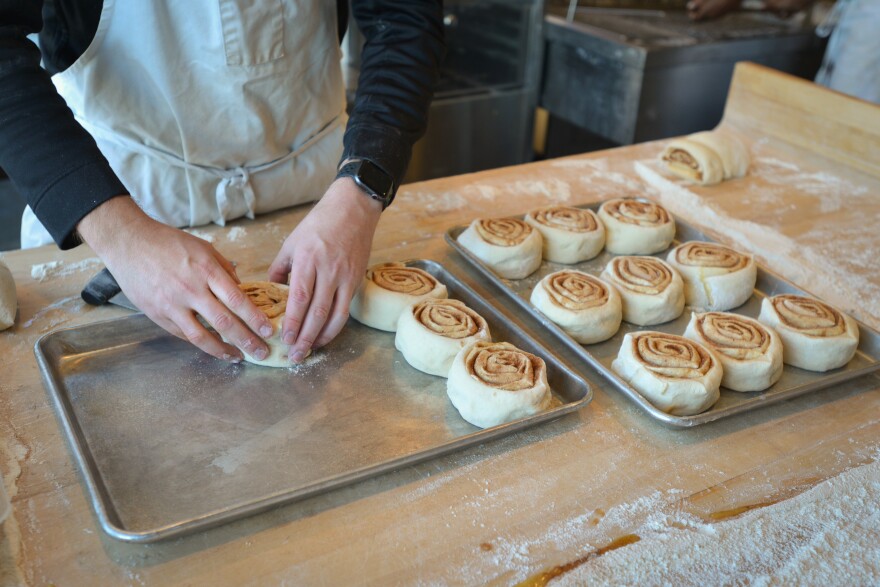For more stories like this one, subscribe to Real Humans on Apple Podcasts, Spotify, Stitcher or wherever you get podcasts.
Growing up in Kansas City in the 1980s, I ate my fair share of conventional cinnamon rolls. You know, the kind with a pinwheel shape and a gooey center, drenched in sticky frosting that pools in every crack and crevice.
But the cinnamon roll that spoke to me most was the one they served at Stroud's, where baskets of buttery dinner rolls covered in cinnamon sugar glaze arrived at the table with every meal. They accompanied fried chicken, mashed potatoes and green beans, making my formative cinnamon roll more savory side dish than stand-alone treat.
This isn't just a personal fixation. To this day, the Stroud's cinnamon roll is an iconic Kansas City delicacy.
Cinnamon rolls, though, don't get top billing as part of Kansas City's food lore. In fact, they rarely enter into that conversation at all. In a city where every household has a strongly-felt and often-stated smoked-meat-and-sauce allegiance, the varied expressions of local cinnamon roll greatness go woefully unacknowledged.
At least, they used to.
In 2017, an article from Condé Nast Traveler made the claim that Kansas City "quietly owns" the cinnamon roll. The author, Khushbu Shah, passed through Kansas City and found the prevalence of cinnamon rolls on local menus astounding.
"Nearly every cafe, bakery, and even a restaurant run by James Beard Award-winning chefs had a cinnamon roll on the menu," Shah wrote. "KC has cinnamon roll making down to a science — to the point that even the airport hotel, typically a wasteland for food, had a delicious one at the breakfast buffet."
But upon further investigation, I'm not sure that Kansas City owns the cinnamon roll. I'd argue that the cinnamon roll owns us. It dominates the Kanas City palate and we don't even know it.

This winter, families across the metro and beyond are getting ready for their own Christmas morning cinnamon roll traditions. So this seems like the perfect time to honor the story of this Kansas City baking obsession.
At Neighborhood Cafe in Lee's Summit and Waldo, cinnamon rolls appear at every table as a complimentary appetizer before you even order. M&M Bakery, a historic deli on East 31st Street right off of 71 Highway, has customers lined up on the sidewalk every morning to choose from multiple cinnamon roll options: baked or fried, iced or plain.
Rye, a hip Sunday brunch destination, sells out of cinnamon rolls early in the day most weekends. Dolce, an upscale bakery in Prairie Village known for luxurious cakes, is home to an updated version of the treat made with orange zest.
Mudpie, a coffeeshop in a cozy little house on West 39th Street, makes a vegan cinnamon roll. At Donutology in Westport, they produce a cinnamon roll bigger than my head.
Black Hole Bakery on Troost and Mildred's downtown have both started making brioche-based cinnamon rolls, which I'm afraid to try for fear of becoming addicted.
TJ Cinnamons, the once-ubiquitous chain dotting shopping mall food courts nationwide, got its start in the 1980s right here in Kansas City, at Ward Parkway Mall, and we're still on the forefront of cinnamon roll innovation today. One entrepreneur, after spending his kids' naptimes trying to recreate the cinnamon-y treats of his dreams, launched a service called Tin Pan Cinnamon Rolls that delivers by the pan-ful.
"We're in the middle of an area where cinnamon rolls just remain very, very popular," says food historian Andrea Broomfield.

Broomfield is the author of the 2016 book "Kansas City: A Food Biography" and the forthcoming "Kansas City’s Lost Restaurants." She traces the popularity of cinnamon rolls back to a handful of individual bakers, whose creations quickly became part of the daily lives of Kansas Citians.
"When you talk to older people, they're probably going to remember Myron Green," Broomfield says, referring to the owner of Myron Green's Cafeteria, a restaurant located downtown in the 1960s. "The thing that made Myron Green so famous was not just the cafeteria, but the bakery. You'd walk by the outside of it, and it was like sheet glass windows full of baked goods. And his cinnamon rolls were incredibly popular."
Broomfield says people who worked in downtown Kansas City would stop by Myron Green's for cinnamon rolls as a treat on their way to the office, or on the way back home for the next morning's breakfast. The item offered an accessible indulgence.
"The Kansas City Star was always publishing reprints of that recipe," Broomfield says, "which tells me that people really had a love for them."
Another Kansas City cinnamon roll innovator was Anna Peterson, who came from a Swedish family and owned a restaurant in Fairway in the 1950s. Peterson's cinnamon rolls were very European: small and dainty, served on the side with lunch.
"It was the opposite of Myron Green's," Broomfield says.
These signature cinnamon rolls set the stage for a food scene where eateries accepted a tacit challenge to put their own spin on this common pastry.

But a significant part of Kansas City's cinnamon roll story doesn't take place in restaurants, or even in Kansas City at all. It begins in the Midwestern farming communities where so many of this city's residents trace their origins.
If you mention cinnamon rolls in Kansas City, a lot of people go straight to a bizarre-sounding food combination once served in local schools on Fridays: chili and cinnamon rolls.
Broomfield explains this phenomenon using the example of her husband's family.
"Vince's folks grew up in Kansas. German farmers, you know, so they were totally self-sustaining with the exception of heading into town to buy sugar and flour, but basically they're producing everything else," she says. "So you've got this family of probably 12 people, most of them working grueling hours from sun up to sun down. Vince's grandmother was always creating massive amounts of food to keep them fed. And the go-to's were always chili and cinnamon rolls."
The combination was practical, especially in the wintertime: Both are high-calorie foods that fueled physical labor and warmed people up at any time of day or night. Most of the ingredients were inexpensive and shelf-stable: beans for the chili, cinnamon, sugar, flour and yeast for the cinnamon rolls. Beef and butter were likely produced right there on the farms.
"If you fill people's stomach up with bread and beans, they're not going to crave as much meat, and they're still going to think they got something that made their day better," Broomfield says.
A beloved tradition, chili and cinnamon rolls migrated from farmhouse tables to school cafeterias and church basements. Broomfield experienced that part of the story herself.
"Everybody looked forward to Friday, because I mean, first of all, you smell it the whole morning," she says. "You're trying to get through math class and reading and all that you smell is this amazing cinnamon aroma. And you're so hungry by 11:00. And of course these lunch ladies are making all of this from scratch."

These two histories — the decadent treat sold in restaurants, and the home-baked pastry to round out a meal — converge at Stroud's, in the cinnamon roll of my youth.
Billing itself as the "home of pan-fried chicken," Stroud's original roadhouse-style restaurant at 85th and Troost is the one I remember vividly. But their rolls are still available at the current locations at Oak Ridge Manor (an old farmstead in the Northland) and in Overland Park.
The original owner, Helen Stroud, started the place as a raucous barbecue stand that sold fireworks and beer. Stroud switched to fried chicken during World War II, when rations made beef too expensive.
But cinnamon rolls didn't enter the picture until after Jim Hogan purchased the spot in 1977, along with a friend and fellow bartender. When he thinks of those cinnamon rolls, Hogan says there's one thing that immediately comes to mind: "The lady who started them. Bea Lewis."
Hogan hired Lewis to do some baking. She started out making dinner rolls in her own home, at 56th and Brooklyn. The ones she favored were Porter House rolls, a notoriously time-consuming but delicious dinner roll that had once been a staple on American dinner tables.

"She made them square, and people loved them. And then one day she brought some in with the cinnamon topping on 'em. I'm like, 'Oh my God,'" Hogan says with a laugh. "'We gotta start doing this now.'"
Hogan says that Lewis' cinnamon rolls were an immediate hit. Customers plowed through massive quantities at their tables, even throwing temper tantrums on the rare occasion when the bottomless baskets ran out.
Lewis, nonetheless, maintained her at-home operation, baking nightly from about 11 p.m. until 5 a.m. For years, hundreds of pans of rolls had to be shuttled back and forth between Lewis' house and the restaurant.
"It's hard work," Hogan says. "She was doing 5,000 cinnamon rolls a night."
Lewis didn't use a recipe. She just knew what she was doing. When it came time for her to retire, the only way to keep the rolls coming was for Hogan to work with her in that basement until he knew what he was doing, too.
"When I worked with Bea, it would be, 'Jim, you need more flour in that dough.' And I'm like, "How? How do you know?' She could look at a batch of dough and say, 'That's not gonna work.'"
Discontinuing Stroud's signature cinnamon rolls was never an option.
"There's lots of chicken places," Hogan confides. "It's just good fried chicken, you know. But it's nothing that nobody's done before. The cinnamon rolls are unique."
Now, at the restaurant, the first question that servers ask a party is: "Do you want your cinnamon rolls with your meal, or after meal as dessert?"

Even though Hogan could make Stroud's cinnamon rolls at home if he wanted to, he doesn't. It's serious labor. Getting the dough ready to bake takes forever.
"You let it rise, you punch it down, you know, then they rise again," he says. "Then you roll it out and cut it of squares and put it on a pan and let 'em rise up again." He seems exhausted just describing it.
Hogan, now retired, still goes to Stroud's for his cinnamon roll fix.
"Once a year, at Christmas, I take all my kids and grandkids," he says. "It's special."
It's not just this one cinnamon roll that's special, though, and it's not just at Christmas. At least in this city, they're all-the-time treats — big or small, iced or plain, baked or fried, with chili or without.
There's undoubtedly one to match your particular taste, or maybe your particular nostalgia, waiting for you in Kansas City, land of cinnamon rolls.







